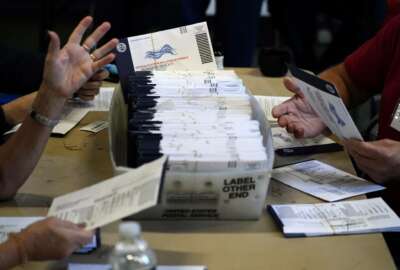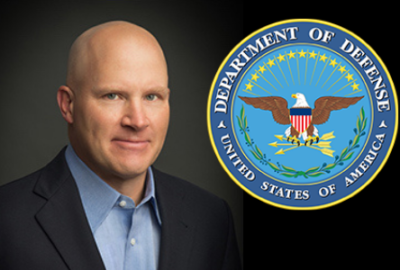To listen to the Federal Newscast on your phone or mobile device, subscribe in PodcastOne or Apple Podcasts. The best listening experience on desktop can be found using Chrome, Firefox or Safari.
- The election might not be settled, but now federal employees can wear their Biden buttons or MAGA hats to the office or on their Zoom meetings. The Office of Special Counsel issued a post-election Hatch Act advisory that, because voting is over, it’s okay — at least legally — to sport hats or T-shirts, or to display pictures while on duty. That goes for people in uniforms or who must also display official insignias. And if you dare, it’s okay to talk about the election results or the candidates. But party or political advocacy while on the job is still prohibited.
- The Department of Veterans Affairs transitioned 415,000 employees to a remote workforce, quickly retrofitted a North Texas hospital, and gave 1,000% percent more telehealth appointments. These were some of the department’s biggest accomplishments in 2020. A report highlights the department’s IT initiatives during the pandemic, which involved the deployment of 199,000 laptops and 11,000 mobile devices.
- The Department of Veterans Affairs is tracking a record number of COVID-19 cases among its veterans, employees and others. Almost 6,500 veterans have active cases. Over 4,000 veterans have died to date due to complications from COVID-19. VA facilities are currently treating 606 inpatients. Another 564 VA employees also have active cases. A total of 63 VA employees have died. VA facilities in Minneapolis, Milwaukee and Chicago are tracking the most active cases. The department so far has performed close to 880,000 tests among veterans and employees.
- A temporary detail program got some interest from federal employees during the pandemic. Over 650 federal employees applied to temporary positions at other federal agencies needing help with their pandemic response. The Office of Personnel Management set up a designated section of USAJobs.gov called Open Opportunities, so employees could apply. Agencies placed just nine employees in temporary COVID details since March. Eight others are in the security clearance process, and another 100 federal employees participated in shorter micro-details with other agencies.
- Starting Dec. 5, contractors and agencies using the Federal Procurement Data System will have to log on using two-factor authentication for each account. The General Services Administration said it will implement the login.gov service as part of how it is increasing the security of the platform. Users will have to create an account or use an existing one with login.gov, or federal employees can use their smart identity cards to authenticate into the system. The requirement for all federal websites to use multi-factor authentication is mandated by the 2016 Cybersecurity National Action Plan.
- The IRS gave an update on next steps for its Enterprise Digitalization and Case Management Office. The agency’s Tax Exempt and Government Entities division will be the first to migrate to the agency’s new cloud-based enterprise case management system in December. The agency said this will enable the division to digitize the more than 30,000 letters and forms it receives every year. The IRS expects to speed up the rate of its migration later this fiscal year, and expects its procurements needs will be roughly $25 million to $50 million for all of fiscal 2021.
- The Navy released a major upgrade to its overhauled pay and personnel IT system. Officials expect the new Navy Personnel and Pay system — or NP2 — to come fully online in January 2022. In the meantime, several new features rolled out just last week. They include the ability for sailors to handle travel vouchers and reimbursements thorough a new automated process, including electronic signatures. The new release also lets sailors view electronic versions of their service records on mobile devices or personal computers, and lets some reservists review and print their mobilization and demobilization orders online.
- The Defense Department wants to bring the technology behind Bitcoin to the military as a service. Blockchain-as-a-service may be coming to DoD. The Defense Information Systems Agency released a request for information to industry asking for details about products and services that can run in a mainframe environment. DISA wants contractors to answer six questions ranging from their technical capabilities to their current contracts to buy blockchain as a service through to their approach to software licensing. Responses to the RFI are due Nov. 10.
- The Cybersecurity and Infrastructure Security Agency is hosting a series of workshops on 5G. It’s working with state, local, tribal and territorial governments to help them understand and prepare for security considerations. The workshops focus on risk management. The first occurred in Washington, D.C. two weeks ago. More than 180 participants attended, including federal agencies, D.C. government, and members of the private sector. The next workshops will occur later this month in Utah and Minnesota.
- CISA’s supply chain risk management task force is looking to address the problem of third party risk management. The task force is putting together a template that will allow vendors to self attest to their security practices. This template would consist of a customized set of questions. Vendors could submit their answers for procurements, giving the purchasers insight into their cyber hygiene. This is just one of a number of the task force’s initiatives to mitigate potential supply chain threats.
- The Postal Service prioritized ballot delivery speed above traceability as part of its “extraordinary measures.” The head of election mail processing for USPS said the agency doesn’t have clear data yet on the number of postmarked ballots still in its system that can be delivered in states that will still accept them. But the agency expected to provide that data by Thursday morning. After a federal court judge ordered sweeps at processing sites, the Postal Service turned up 13 ballots in processing sites in Pennsylvania, and 815 ballots left behind in facilities in Texas. (Federal News Network)
Copyright
© 2025 Federal News Network. All rights reserved. This website is not intended for users located within the European Economic Area.




